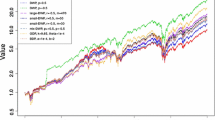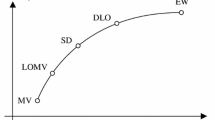Abstract
A market model in Stochastic Portfolio Theory is a finite system of strictly positive stochastic processes. Each process represents the capitalization of a certain stock. If at any time no stock dominates almost the entire market, which means that its share of total market capitalization is not very close to one, then the market is called diverse. There are several ways to outperform diverse markets and get an arbitrage opportunity, and this makes these markets interesting. A feature of real-world markets is that stocks with smaller capitalizations have larger drift coefficients. Some models, like the volatility-stabilized model, try to capture this property, but they are not diverse. In an attempt to combine this feature with diversity, we construct a new class of market models. We find simple, easy-to-test sufficient conditions for them to be diverse and other sufficient conditions for them not to be diverse.
Similar content being viewed by others
References
Audrino, F., Fernholz, R., Ferretti, R.G.: A forecasting model for stock market diversity. Ann Financ 3(2), 213–240 (2007)
Banner, A.D., Fernholz, D.: Short-term relative arbitrage in volatility-stabilized markets. Ann Financ 4(4), 445–454 (2008)
Banner, A.D., Fernholz, R., Karatzas, I.: Atlas models of equity markets. Ann Appl Probab 15(4), 2296–2330 (2005)
Chatterjee, S., Pal, S.: A phase transition behavior for Brownian motions interacting through their ranks. Probab Theory Relat Fields 147(1–2), 123–159 (2010)
Durrett, R.: Stochastic Calculus: A Practical Introduction. Probability and Stochastics Series. Boca Raton: CRC Press (1996)
Fernholz, R.: Stochastic portfolio theory, volume 48 of Applications of Mathematics (New York), Stochastic Modelling and Applied Probability. New York: Springer (2002)
Fernholz, R., Ichiba, T., Karatzas, I.: Two Brownian particles with rank-based characteristics and skew-elastic collisions. Stoch Process Appl 123(8), 2999–3026 (2013)
Fernholz, R., Karatzas, I.: Relative arbitrage in volatility-stabilized markets. Ann Financ 1, 149–177 (2005)
Fernholz, R., Karatzas, I.: Stochastic portfolio theory: an overview. Handb Numer Anal 15, 89–167 (2009)
Fernholz, R., Karatzas, I., Kardaras, C.: Diversity and relative arbitrage in equity markets. Financ Stoch 9(1), 1–27 (2005)
Hajek, B.: Mean stochastic comparison of diffusions. Z Wahrsch Verw Gebiete 68(3), 315–329 (1985)
Ichiba, T.: Topics in multi-dimensional diffusion theory: attainability, reflection, ergodicity and rankings. ProQuest LLC, Ann Arbor, MI. Thesis (Ph.D.). Columbia University (2009)
Ichiba, T., Karatzas, I., Shkolnikov, M.: Strong solutions of stochastic equations with rank-based coefficients. Probab Theory Relat Fields 156(1–2), 229–248 (2013)
Ichiba, T., Papathanakos, V., Banner, A., Karatzas, I., Fernholz, R.: Hybrid atlas models. Ann Appl Probab 21(2), 609–644 (2011)
Ikeda, N., Watanabe, S.: Stochastic Differential Equations and Diffusion Processes, Volume 24 of North-Holland Mathematical Library, 2nd edition. Amsterdam: North-Holland Publishing Co. (1989)
Karatzas, I., Pal, S., Shkolnikov, M.: Systems of brownian particles with asymmetric collisions. Preprint. Available at arXiv:1210.0259v1 (2012)
Karatzas, I., Shreve, E.S.: Brownian Motion and Stochastic Calculus, Volume 113 of Graduate Texts in Mathematics, 2nd edition. New York: Springer (1991)
Kardaras, C.: Balance, growth and diversity of financial markets. Ann Financ 4(3), 369–397 (2008)
Osterrieder, J.R., Rheinlander, T.: Arbitrage opportunities in diverse markets via a non-equivalent measure change. Ann Financ 2, 287–301 (2006)
Pal, S.: Analysis of market weights under volatility-stabilized market models. Ann Appl Probab 21(3), 1180–1213 (2011)
Pal, S., Pitman, J.: One-dimensional Brownian particle systems with rank-dependent drifts. Ann Appl Probab 18(6), 2179–2207 (2008)
Pal, S., Shkolnikov, M.: Concentration of measure for systems of brownian particles interacting through their ranks. Preprint. Available at arXiv:1011.2443 (2010)
Pickova, R.: Generalized volatility-stabilized processes. Ann Financ 1–25 (2013)
Shkolnikov, M.: Competing particle systems evolving by interacting Lévy processes. Ann Appl Probab 21(5), 1911–1932 (2011)
Shkolnikov, M.: Large volatility-stabilized markets. Stoch Process Appl 123(1), 212–228 (2013)
Strong, W., Fouque, J.-P.: Diversity and arbitrage in a regulatory breakup model. Ann Financ 7, 349–374 (2011)
Acknowledgments
I would like to thank Professor Tomoyuki Ichiba for suggesting this problem. I would also like to thank my adviser, Professor Soumik Pal, for help and encouragement. I am thankful to an anonymous referee for reading this article very carefully, and making lots of useful comments. Last but not least, I am indebted to Professor Ioannis Karatzas for useful discussion and valuable comments which, in particular, helped clarify the proof of Theorem 2.
Author information
Authors and Affiliations
Corresponding author
Appendix
Appendix
Let us state Feller’s test for explosions. It is taken from Durrett (1996, Section 6.2). Fix an interval \((\alpha , \beta ) \subseteq \mathbb {R}\) and a point \(x_0 \in (\alpha , \beta )\). Let \(X(\cdot ) = (X(t), t \ge 0)\) be a real-valued stochastic process satisfying the following stochastic differential equation:
Here, \(B = (B(t), t \ge 0)\) is a one-dimensional standard Brownian motion, and \(b, \sigma : (\alpha , \beta ) \rightarrow \mathbb {R}\) are continuous functions such that \(\sigma ^2(x) > 0\) for all \(x \in (\alpha , \beta )\). Define the natural scale as
Also, let
Finally, define the following integrals:
Proposition 1
-
(i)
If \(\varphi (\alpha ) = -\infty \), or \(\varphi (\alpha ) > -\infty \) and \(I_{\alpha } = \infty \), then the process \(X(\cdot )\) a.s. does not hit \(\alpha \). Otherwise, it does hit \(\alpha \) with positive probability.
-
(ii)
If \(\varphi (\beta ) = \infty \), or \(\varphi (\beta ) < \infty \) but \(I_{\beta } = \infty \), then the process \(X(\cdot )\) a.s. does not hit \(\beta \). Otherwise, it does hit \(\beta \) with positive probability.
Proof of Lemma 1
From (2), we have:
and
Therefore,
Apply Ito’s formula to \(X_i(t)/S(t)\). Let \(f(x, y) = x/y\), then
Therefore, we have:
We can express this in terms of market weights as
Lemma 2
Assume \(X = (X_t, t \ge 0)\) is a progressively measurable continuous stochastic process such that
where \(B\) is an \((\mathcal F_t)_{t \ge 0}\)-Brownian motion, and the processes \(\gamma = (\gamma _t)_{t \ge 0}\) and \(\rho = (\rho _t)_{t \ge 0}\) are progressively measurable. Assume that, for some constants \(0 < \varkappa _1 \le \varkappa _2\), we have the following estimate:
where \(\sigma : \mathbb {R}\rightarrow (0, \infty )\) is a continuous real-valued function. Then the following time-change process
is a strictly increasing function, \(\Delta (0) = 0,\ \Delta (\infty ) = \infty \). Define its inverse:
The family \((\mathcal F_{\tau (s)})_{s \ge 0}\) of \(\sigma \)-algebras is a filtration satisfying the usual conditions. Moreover, the process \(Z = (Z_s = X_{\tau (s)})_{s \ge 0}\) satisfies the equation
where \(B = (B_s)_{s \ge 0}\) is another \((\mathcal F_{\tau (s)})_{s \ge 0}\)-Brownian motion.
Proof
Analogous to Hajek (1985, Section 3). For \(s \ge 0\), we have:
Let us change variables in the first integral from the right-hand side of (22): \(u = \tau (v),\ v = \Delta (u),\ 0 \le v \le s\). Then
Therefore,
Now, consider the Itô integral from the right-hand side of the (22): let
Then \(M = (M_t)_{t \ge 0}\) is a continuous \((\mathcal F_t)_{t \ge 0}\)-martingale with \(<M>_t = \Delta (t)\), and
By Karatzas and Shreve (1991, Theorem 3.4.6), \(M_t = B_{\Delta (t)}\) for \(t \ge 0\), where \(B = (B_s)_{s \ge 0}\) defined by \(B_s = M_{\tau (s)},\ s \ge 0\) is another \((\mathcal F_{\tau (s)})_{s \ge 0}\)-Brownian motion, and this filtration satisfies the usual conditions. By Karatzas and Shreve (1991, Proposition 3.4.8),
Since \(\Delta (\tau (s)) = s\), we have:
Thus, for \(s \ge 0\) we have:
which completes the proof.
Lemma 3
Assume \(X = (X_t)_{t \ge 0}\) and \(Y = (Y_t)_{t \ge 0}\) are two progressively measurable continuous stochastic processes which satisfy
Here, \(\beta = (\beta _t)_{t \ge 0}\) is a progressively measurable process, and \(b,\ \sigma : \mathbb {R}\rightarrow \mathbb {R}\) are real-valued continuous functions. If \(\beta _t \le b(X_t)\) a.s. for \(t \ge 0\), then \(X_t \le Y_t\) a.s. for \(t \ge 0\). If \(\beta _t \ge b(X_t)\) a.s. for \(t \ge 0\), then \(X_t \ge Y_t\) a.s. for \(t \ge 0\).
Proof
Follows from Ikeda and Watanabe (1989, Lemma 6.1).
Rights and permissions
About this article
Cite this article
Sarantsev, A. On a class of diverse market models. Ann Finance 10, 291–314 (2014). https://doi.org/10.1007/s10436-013-0245-2
Received:
Accepted:
Published:
Issue Date:
DOI: https://doi.org/10.1007/s10436-013-0245-2




